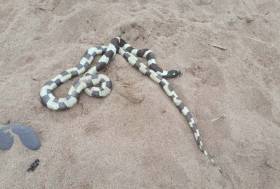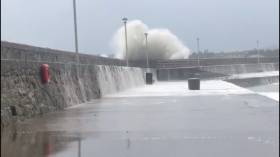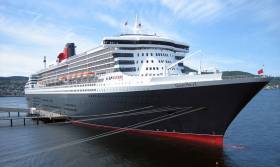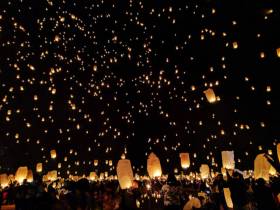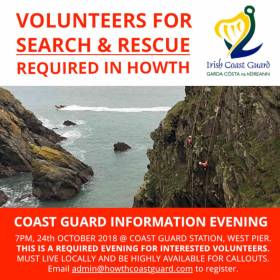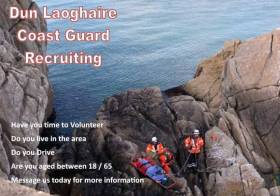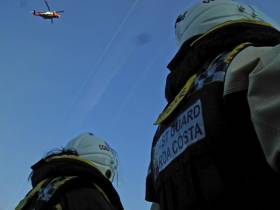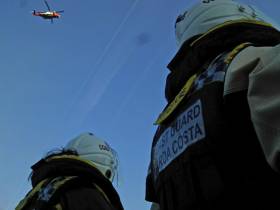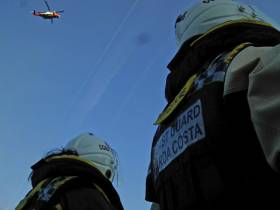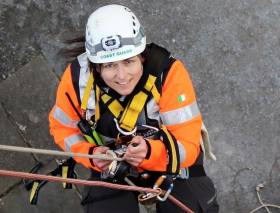Displaying items by tag: Irish Coast Guard
Snake Surprises Coastguard On Youghal Beach
A reptile feared to be a venomous turtle-headed sea snake was found on a beach on the East Cork coast on Thursday 3 January, as the Irish Examiner reports.
However, minds were put at ease when the dead snake spotted by the local coastguard on Youghal Beach turned out to be a California kingsnake — a non-venomous species that had likely been kept as a pet.
It’s not yet known now the 1.5-metre snake came to be on the beach. The Irish Examiner has more here.
Irish Coast Guard Responds To Storm-Related Incidents
Irish Coast Guard teams across Ireland have responded to incidents related to the extreme conditions brought by Storm Diana over the last two days.
Dun Laoghaire Coast Guard was tasked at lunchtime on Tuesday (27 November) to extract a member of the public that had walked out the South Bull wall during stormy conditions.
The safest option in that situation was the casualty to take shelter until the tide dropped.
Yesterday afternoon (Wednesday 28 November), the team was called out to the Shankill shoreline close to Shanganagh Water Treatment plant to reports of a vehicle submerged in water with person a trapped.
Dun Laoghaire Coast Guard were tasked immediately along with Rescue 116 from Dublin Airport and Dun Laoghaire RNLI. While crews were responding to the incident, the casualty was rescued by his colleagues. All crews were stood down.
Shortly after, Dun Laoghaire Coast Guard was tasked to another incident at the town’s East Pier, where members of the public were stranded due to waves breaching the pier wall.
On arrival, Dun Laoghaire Coast Guard members identified a few members of public on the pier and advised them to relocate to a safer location.
Elsewhere, Crosshaven Coast Guard was tasked several times, starting on Tuesday evening with a person who had fallen overboard from a yacht and had been in the water for almost an hour.
The casualty was evacuated to Crosshaven RNLI’s lifeboat station, while the coastguard crew refloated their vessel that had gone aground.
Crosshaven was tasked again yesterday morning to recover a yacht after it broke its mooring near Drakes Pool. A tow was quickly established and casualty vessel brought to safety to a Royal Cork Yacht Club mooring.
The Irish Coast Guard strongly advises the public to stay away from exposed beaches, cliffs and piers, harbour walls and promenades along the coast during storm conditions.
Remember to Stay Back, Stay High and Stay Dry.
If you see someone in difficulty in the sea, or on the shore dial 999/112 and ask for the coastguard.
Medevac From Queen Mary 2 Off Irish Coast Is Second In 13 Months
The Clare Herald reports on a helicopter medevac from the Queen Mary 2 off the Irish coast earlier this week.
Rescue 115 from the Irish Coast Guard was involved in the evacuation of an elderly woman to University Hospital Limerick from the luxury ocean liner on Monday afternoon (19 November).
The incident came just over a year after an elderly man with a suspected heart problem was evacuated from the same liner off West Cork.
Sky Lanterns: Don’t Put Emergency Services Under Unnecessary Strain, Coastguard Appeals
Dun Laoghaire Coast Guard has issued an appeal against the use of sky lanterns ahead of next week’s Hallowe’en celebrations.
Sometimes called Chinese lanterns, the airborne paper lights carry a flame inside and are often used at social occasions such as birthdays and weddings.
But the lanterns pose a risk to aviation, as well as a nuisance to rescue services which have responded to countless false alarms over presumed emergency flares.
The burning lanterns also pose fire and health risks to land and livestock.
Anyone planning to use such lanterns needs prior permission from the Irish Aviation Authority, which also restricts launches to no more than 50 lanterns.
Dun Laoghaire Coast Guard has the relevant contact details on its Facebook page.
Volunteers Wanted For Howth Coast Guard
#Coastguard - Howth’s Irish Coast Guard unit is looking to recruit and train three new volunteers in 2019.
If you live very locally to the North Co Dublin coastguard unit and are highly available, interested volunteers must attend an information evening at the West Pier coastguard station on Wednesday 24 October.
This meeting is mandatory if you wish to be considered for one of these three trainee positions.
To register your attendance email [email protected].
Recently Dun Laoghaire Coast Guard put out their own call for potential new volunteers to join South Co Dublin unit.
Dun Laoghaire Coastguard Recruiting New Volunteers
#Coastguard - Do you live in or around Dun Laoghaire and have time to volunteer? Do you drive? Are you aged between 18 and 65?
If so, you may be the right fit for Dun Laoghaire Coastguard, which is currently running a recruitment drive.
Send the unit a message via Dun Laoghaire Coastguard's official Facebook page with your details for further information about the important lifesaving role.
Minister Accepts Recommendations Of Report On Irish Search & Rescue Oversight
#SAR - The report of a team appointed to review “oversight” in Ireland’s search and rescue aviation operations has been published.
Among its short-term recommendations is that the Department of Transport, Tourism and Sport (DTTAS) “formally and clearly assigns” the Irish Aviation Authority (IAA) “with responsibility for the legal and safety oversight” of civil aviation SAR.
In the medium term, it is recommended that the IAA be directed to develop “clear and unambiguous” regulatory material for SAR “that is appropriate to the scale and complexity of the national aviation system”, and that roles and responsibilities are “assigned appropriately … [with] a consistent, shared understanding”.
The report says it is “evident that the regulatory arrangements for search and rescue are a hybrid of maritime and aviation depending on which assets are deployed and in what circumstances.”
But it also stresses that Ireland “is not exceptional” in this regard, and that its recommendations show “learnings which will be relevant to other jurisdictions”.
Transport Minister Shane Ross has considered the report and accepts in full its 12 recommendations.
The review was conducted as a direct response to the Air Accident Investigation Unit’s (AAIU) interim statement in March as its own investigation into the Rescue 116 incident remains ongoing after more than a year due to its “depth and breadth”.
An international team of aviation and SAR experts worked on the report, which was completed in early August and submitted to the AAIU along with a series of follow-up actions to ensure full implementation of the its recommendations.
The AAIU says it has had an opportunity to consider the report in the context of its “wide-ranging investigation into the R116 accident and is happy that its publication does not jeopardise any other element of its ongoing investigation.”
As the report states, the review did not examine the specific circumstances in relation to the Rescue 116 accident and as such, there is no intention to establish any causal link between their findings and the accident.
Speaking upon the publication of the report today (Friday 21 September), Minister Ross said: “I have instructed that all necessary steps be taken without delay to ensure speedy implementation of all of the recommendations.
“As the report explains, search and rescue oversight and regulation is a complex matter, and international regulation is still endeavouring to keep pace with practice on the ground.
“However, we now have an opportunity in Ireland — and a blueprint – to make meaningful improvement to our current oversight structures, and in doing so set a benchmark for other jurisdictions.”
The minister said he will continue to provide updates to the AAIU on the progress in implementing these actions.
The report is available as a PDF to read or download from the DTTAS website HERE.
Coastguard In Night Rescue Of Angler After Galway Bay Cliff Fall
#Rescue - A night angler was rescued after falling from a cliff on Galway Bay in the early hours of yesterday morning (Saturday 8 September), as BreakingNews.ie reports.
Doolin Coast Guard’s cliff rescue specialists joined emergency services near Black Head Lighthouse after 1am, while the Irish Coast Guard’s Shannon-based helicopter Rescue 115 was also tasked.
The cliff rescue crew faced difficult conditions as they located and secured the casualty for airlift to University Hospital Galway.
BreakingNews.ie has more on the story HERE.
Irish SAR Review Points To Confusion Among Agencies
#SAR - A team appointed to review Irish search and rescue operations in the wake of last year’s fatal Rescue 116 crash has identified “several sources of confusion and potential conflicts of interest among the agencies involved”.
RTÉ News reports on the as-yet unpublished report from an international panel of aviation and SAR experts appointed earlier this year by Transport Minister Shane Ross.
The panel did not examine the Rescue 116 crash at Blackrock, which is subject to its own report, and was tasked only with reviewing matters in relation of “oversight” of Irish SAR operations.
Their report says that confusion over the roles of the various agencies involved in civil aviation SAR has “resulted in a lack of shared understanding of roles and responsibilities”.
RTÉ News has more on the story HERE.
#Coastguard - There was no evidence of effective management at Kilkee’s coastguard station when volunteer Caitríona Lucas died during a rescue operation almost two years ago, according to a draft report into the incident.
The Irish Times has details of the draft report from the Marine Casualty Investigation Board (MCIB), which adds that the RIB on which Lucas was travelling before it capsized on 12 September 2016 was being used outside of the Irish Coast Guard’s own operational limits.
Parallels were also drawn to a similar incident two years prior involving a coastguard RIB in a “surf zone” near Dingle, which prompted a series of recommendation that were not “fully implemented” by the Irish Coast Guard, according to the MCIB.
The Irish Times has much more on the story, while Lorna Siggins also writes on how Lucas’ death occurred amid a tumultuous time for the Co Clare coastguard unit.


























